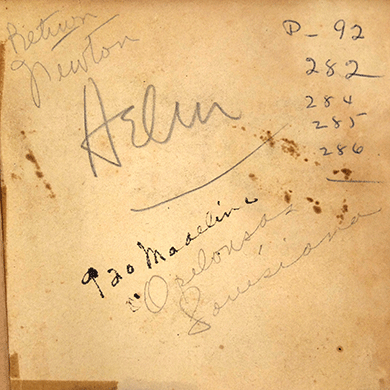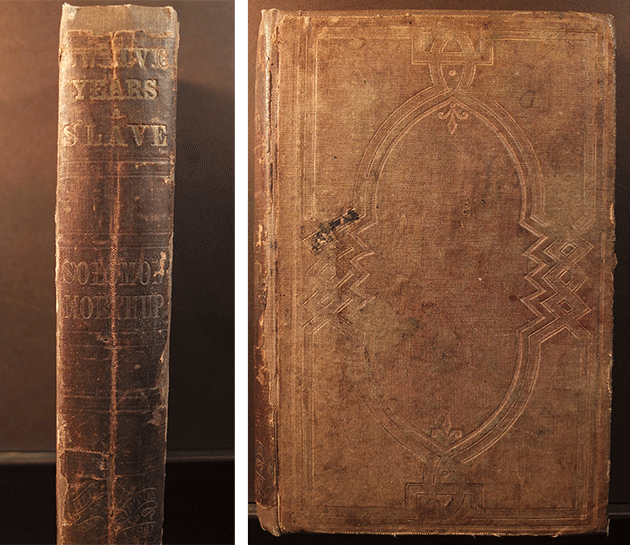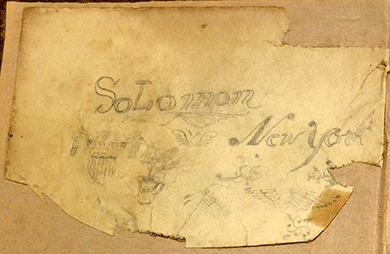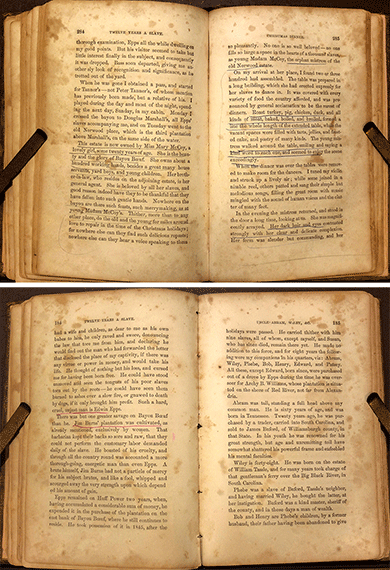In the Margins of Twelve Years a Slave
Tracing an original edition of Solomon Northup’s narrative to a slaveholder
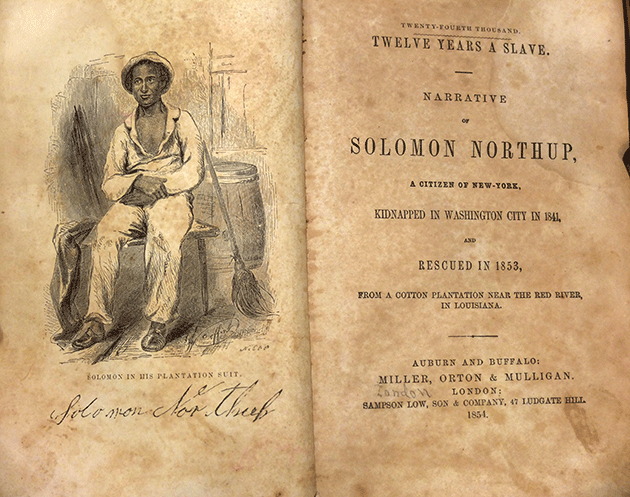
Figure 1 — Title page and portrait of Solomon Northup from the McCoy family’s original 1853 edition of Twelve Years a Slave. All photographs © Mary Niall Mitchell. Courtesy of Caroline Helm
The McCoy family’s original 1853 edition of Solomon Northup’s Twelve Years a Slave has at least five authors. There was Northup himself, of course, a free black man who provided the details of his illegal enslavement in the Deep South, and his white editor and amanuensis, David O. Wilson. Beyond the two principals, at least three others made their own additions to the book. Some in pen, but most in pencil. Sorting out who wrote what, and when they wrote it, is mostly a guessing game, but a telling one even still. Northup’s account — which any reader knows was bloody and brutal at times — inspired unexpected kinds of reflection.
The story, familiar to those who have seen Steve McQueen’s film adaptation, begins with the trials of Solomon Northup himself, who, while living with his wife and children in Saratoga, New York, was lured away on false pretenses and sold into slavery in Louisiana in 1841. Northup remained enslaved on Bayou Boeuf, in the central part of the state, near the town of Cheneyville, for twelve years until he was redeemed. He published Twelve Years a Slave in 1853, with the help of lawyer and aspiring writer David O. Wilson. Published just one year after Harriet Beecher Stowe’s Uncle Tom’s Cabin, it sold tens of thousands of copies in the North and in Europe. For those opposed to slavery, Northup’s account of its brutalities affirmed what Stowe had illustrated through fiction. [Fig. 1]
Mary McCoy, the matriarch of the McCoy family, was not an abolitionist. She owned a large number of slaves in the Bayou Boeuf region. McCoy (1834–1913) merited some two pages of description in Twelve Years a Slave, all of it positive. Unlike the man who owned Northup longest and last, Edwin Epps, a master who “could have stood unmoved and seen the tongues of his poor slaves torn out by the roots,” Mary McCoy was an “angel of kindness.” The orphaned heiress of the neighboring Norwood Plantation, McCoy was “the beauty and the glory of Bayou Boeuf.” “No one is so well beloved — no one fills so large a space in the hearts of a thousand slaves, as young Madam McCoy.” She was known for staging generous Christmas feasts for her slaves, and on one such occasion, she hired Northup to play his violin.
The McCoy family’s original copy of Twelve Years a Slave probably belonged to Mary. I was able to see it thanks to her great-great-grandaughter, Caroline Helm, who came to own the volume quite by accident. After the death of her father, she inherited a large, glass-fronted mahogany secretary that once stood in the Norwood Plantation. Inside, she found the original copy of Northup’s book. The only clear mark of ownership is that of her grandson, Newton Helm (1877–1952). [Fig. 2] Caroline remembers being given a paperback copy of the book as a child, but finding the original edition was a surprise. (A few months before the movie opened, she took it to be assessed on the PBS series Antiques Roadshow in Lafayette, Louisiana. She did not know about the upcoming film and apparently neither did the experts, who said her heirloom was only worth about $100.)
The book’s front pages and text have been annotated and re-annotated over the years, in pencil, then blue ink, then red. [Figs. 3-4] The markings point to a fascinating irony: despite the brutality Twelve Years a Slave described, the narrative of Solomon Northup was endearing to readers in the Deep South as well as the North, albeit for very different reasons.
For most northern readers, Northup’s story cut to the heart of the struggle over slavery in 1850s America and pointed to the dangers it posed for American liberty. But for the McCoy family, its greatest appeal was Northup’s vivid depictions of the Bayou Boeuf community in which he was enslaved, and especially the glowing picture he left behind of Mary.
We might owe the first revival of Northup’s story in part to his recollections of this “beauty” of the bayou. Mary McCoy’s descendants loaned their edition to a family friend enrolled in a history course at Louisiana State University–New Orleans (now the University of New Orleans) in the mid-1960s. The student took it to her professor, Joseph Logsdon, who read it and decided it should be reprinted. Logsdon and another professor, Sue Eakin, co-edited the first modern reprint of the book, published in 1968.
If there is a poetics of marginalia, as the historian H.J. Jackson has proposed — with the best annotations being clear, economical, and engaged with the text — there is also a peculiar politics to the scribbler’s genre. The artful and at times ardent elaboration found in its margins and other once-blank spaces are hard to anchor precisely in place and time, yet the annotators’ desire to leave a mark on Northup’s story is palpable.
Some of the marks hint at a life in New York, before the book reached central Louisiana. In the back, in very faint pencil on one of the end papers, “Burnt Hills, Saratoga Co., N.Y” is written at an angle, suggesting that it may have been the book’s point of origin. [Fig. 5] Burnt Hills is near where Northup and his family lived before his kidnapping and just outside the Saratoga county seat where Northup’s kidnappers faced trial after Northup’s redemption from slavery. Near that, written in a different hand, is the date “Sept. 22, 1866,” which may have marked the book’s arrival in Bayou Boeuf.
More enchanting is the artwork on the front paste-down, inside the cover, which will look familiar to anyone who has encountered such doodles in Victorian-era diaries. [Fig. 6]. The pictures that frame the words “Solomon New York” — eagle’s wings, the American shield, the U.S. flag, and decorative leaves and vines — suggest they may have been drawn at the time of the Civil War, when such designs appeared on everything from postcards to sheet music. Or perhaps they were drawn even later, during the 1876 Centennial, when patriotic symbols were again in vogue. Regardless, the illustrations evoke the patriotic significance of Northup’s tale: the man who endured twelve years of unlawful slavery, bonded with the defense of the Union from such crimes.
The author of the later inscriptions was the wife of Mary McCoy’s grandson, Newton Helm. [Fig. 7] Sometime in the 1920s or ’30s, Corine Helm delineated on the blank front pages Mary McCoy’s three marriages and the children each produced. Later, with blue ballpoint, she added her own cheeky commentary. McCoy’s first husband, Dr. Dewitt Rhodes M.D. “never worked” and neither did his married son John; the second husband, Austin Burgess was “invalid for 5 yrs.” Corine’s husband was the offspring of a child from McCoy’s third marriage, to a Methodist preacher named Silas Cooper, about whom no comments were made aside from his vocation.
Along the bottom of the first page, she wrote in pencil “Inherited all land + slaves from Grandfather John Dunwoody” with “Mary McCoy” and a red arrow written above it. Helm also made a point of underlining, in blue, all of the parts in the book about McCoy’s benevolence towards her slaves, including his description of the abundant Christmas feast: “roast turkey, pig, chicken, duck, all kinds of meat, baked, boiled, and broiled formed a line the whole length of the extended table. . . . The young mistress walked around the table, smiling and saying a kind word to each one, and seemed to enjoy the scene exceedingly.” [Fig. 8] In red ink, she marked references to the cruelties of Edwin Epps, Northup’s longest owner and another neighbor, Jim Burns, the only “greater savage on Bayou Boeuf.” [Fig. 9]
Did Corine Helm gloss over her family’s history of slaveholding? No. Was her engagement with Northup’s words one-sided? Surely. As H.J. Jackson points out, marginalia is less like a conversation with the author than like someone screaming at the television set. But what is intriguing is that she felt compelled to make her marks between the covers of a slave narrative, a genre many people in the early twentieth century, including historians, found highly suspect, if not entirely fabricated. By the late nineteenth century, Northup’s narrative was no longer in print, and the testimonies of former slaves had been omitted from new interpretations of the Civil War. With slavery left by the wayside, commemorations of the war were by the 1920s being rendered as a bitter fight between brothers — white brothers — that ultimately restored the Union.
For Helm, however, the truth of Northup’s story was never in doubt. Nor was it for several other families in the Cheneyville community who kept copies of Twelve Years a Slave in their libraries, where it served as a narrative snapshot of their neighborhood and its inhabitants before the Civil War. At least here, in Northup’s telling, their history had been recorded. Which brings us to a second irony of the McCoy tome, one Solomon Northup might have appreciated: it is a place where we find slaveholders, not the people they enslaved, confined to the margins, struggling to be heard and hoping to be remembered.
Mary Niall Mitchell is Joseph Tregle Professor in Early American History, Ethel & Herman Midlo Chair in New Orleans Studies, and Associate Professor at the University of New Orleans.

